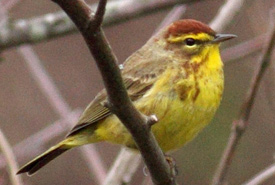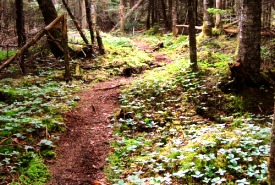Hey Florida, hey Virginia...The birds are meandering back!

Palm warbler (Photo by Marshall Faintich)
The fall migration for warblers is often a leisurely and spread out event spanning August to October. As I am in the midst of the back-to-school rush with my five-year-old twins, warblers are meandering back down south, taking their time in fair fall weather, unlike during the more focused spring migration.
The male palm warblers (sometimes called the yellow palm warbler when you are looking at the eastern sub-species) are no longer singing with their weak, dry trill as the mating rituals are over. With their young having hatched and fledged, these little birds are in no particular hurry; no backpacks to buy or new pencils to sharpen. I know the quieter seasons are upon us and I relish the change.
The endless cycle
The spread out timing of the warbler’s fall migration makes it harder to pinpoint when to go birding, so this migration tends to get less attention than the one in spring. But the fall migration is a critical component of the life cycle for many birds, especially for the young that are making their first long distance flight.
Did you know that in Florida people rarely hear the palm warbler? In the autumn it falls quiet here as well; the males mainly sing only when they are establishing breeding territories. The yellow palm migrates at night, and even in northern areas, where the temperature drops sooner, the species often lingers into late September. Palm warblers shift their migration times depending on temperature, leaving earlier should the weather snap cold too early.
According to the 1966-2014 North American Breeding Bird Survey populations of palm warbler are stable and the species did not make the 2016 State of the Birds Watch List. Their breeding population has been estimated by Partners in Flight to be 13 million. Through their migration, palm warblers link the habitats and conservation issues of North America, with most of them breeding in Canada, and then wintering in the southeastern U.S. and Mexico.
Turning the quiet up
“Some days, we just need to turn the quiet up.” — Dr. SunWolf
The fall is a marvelous time to get out and enjoy locations like the Musquash Estuary in New Brunswick or the Frontenac Arch in Ontario. For me the fall season has always been a time for meditation and quiet reflection. But even a few minutes of quiet on a family walk lets families re-connect with nature and to see the warbler migration through some favourite places — places that might not be there if Nature Conservancy of Canada had not protected them.
As you wander the trails in the cooling fall air, pause to mentally send out a thank you to everyone who, through acts big and small, are helping to protect nature. And as children run through the trees, look forward to the day they too will “turn the quiet up” and see the hidden beauty of the fall migration.
Get out and see the fall migration

Musquash Nature Reserve trail, NB (Photo by NCC)
The fall migration is a great time to birdwatch. The prolonged time of birds trickling through the region provides more opportunities for bird-watching. It’s also a great time to observe both adult and young birds on their journey. If you are visiting New Brunswick, be sure to check out the Nature Conservancy of Canada’s Musquash Estuary Nature Reserve. The forests along the coastal Bay of Fundy provide great habitat and shelter for warblers. Birding New Brunswick is a forum where you can get the scoop on birding hotspots (such as Miscou Island and Johnson’s Mills) as well as tips from locals.
This international blog exchange “One Sky Our Birds” is just one way of celebrating the centennial of the Migratory Bird Treaty and successes in last 100 years of cross-border conservation. It is an opportunity to recognize the myriad of organizations, citizen scientists, government and nonprofits that are helping to protect North America’s lands and waters — and the species they sustain.
So each time you look up and see a palm warbler, remember conservation is vital to helping migratory birds, because birds don’t do borders.
More information about the palm warbler can be found at https://www.allaboutbirds.org/guide/Palm_Warbler/lifehistory
Tune in for more posts from our partners in the One Sky Our Birds blog exchange.


